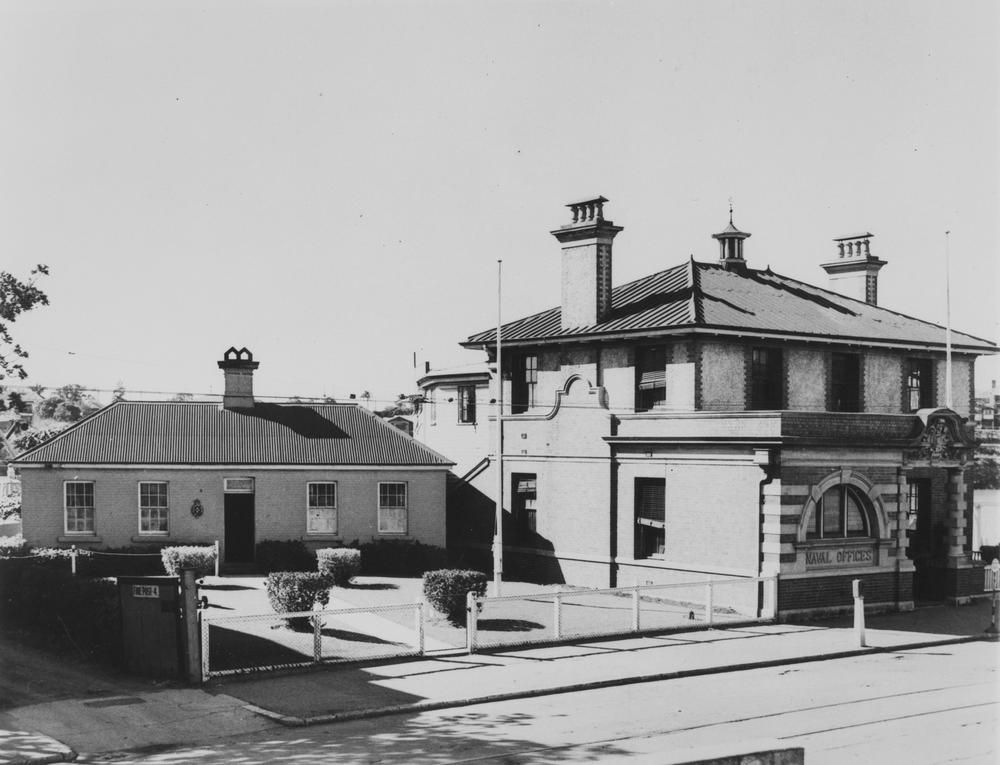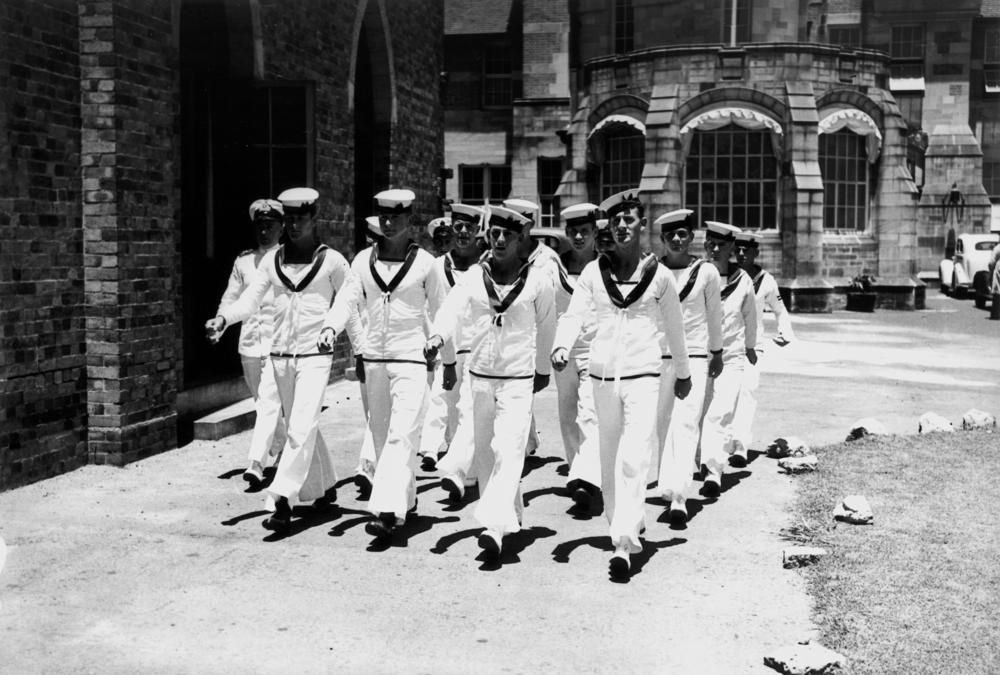Royal Australian Navy
On the outbreak of war in the Pacific, the bulk of the Royal Australian Navy was deployed in the Mediterranean and the Atlantic. The larger ships were then rapidly deployed to protect Australia from possible Japanese invasion. Several of these ships helped defeat a Japanese force in the Battle of the Coal Sea. The ports in Brisbane, Townsville and Cairns were rapidly expanded to became significant naval bases supporting the Allied campaign in the south west Pacific.
Battle of the Coral Sea
On the eve of war with Japan in December 1941 the Royal Australian Navy (RAN) had only five heavy warships in home waters. The bulk of the fleet was serving with the Royal Navy in the Mediterranean and Atlantic. Only weeks earlier the cruiser HMAS Sydney had been sunk by a German armed merchant ship off Western Australia. On 7 December 1941 Japan launched an assault on the Pacific with a surprise attack on the US naval base at Pearl Harbor and the invasion of Thailand and Malaya. Three days later two capital warships of the Royal Navy were sunk off the fortress of Singapore, giving the Japanese almost total control to the seas to Australia’s north.
After taking Rabaul the Japanese began assembling an invasion force for the capture of Port Moresby on the southern coast of New Guinea. On 1 May 1942 the cruisers HMAS Australia and HMAS Hobart were ordered to rendezvous in the Coral Sea with the USS Chicago and three escort destroyers (USS Perkins, Farragut and Walke) by 4 May, to form Task Group 17.3 to cover the US Carrier Task Force 17, headed by USS Yorktown and USS Lexington. The naval air battle began on the morning of 7 May with the sinking of the Japanese carrier Shoho by the Americans, and the crippling of the US oiler Neosho and the sinking of its escort USS Sims by the Japanese. The Task Group led by HMAS Australia, was ordered to block the invasion force off the tip of New Guinea. The Group narrowly survived several attacks by land-based aircraft. On 8 May both forces were still over the horizon and out of sight of each other. In the ensuing naval air battles the Americans lost the carrier Lexington while the Japanese heavy carrier Shokaku was badly damaged and the Zuikaku was left depleted of pilots and aircraft. The Japanese invasion force turned back to Rabaul and Truk.
At the time, the Battle of the Coral Sea was widely seen as the destruction of a powerful Japanese invasion force that was bound for north Queensland. However the Japanese Army had already vetoed its Navy’s proposal to invade Australia. The actual significance of the Coral Sea battle was in the strategic edge gained by US forces a month later in the Battle of Midway Island. In the Coral Sea, the US had lost one fleet carrier while the Japanese lost one light carrier and were forced to withdraw a heavy carrier for repairs to battle damage. Instead of facing six Japanese aircraft carriers, the three US carriers available, met only four. With tactics based on detailed knowledge of Japanese intentions, the Americans succeeded in sinking all four Japanese carriers for the loss of one of their own–USS Yorktown. Victory at Midway proved to be the psychological turning point in the Pacific war. In the minds of most Australians, the threat of immediate invasion was over.
Fortress Brisbane
The Brisbane River became the focus for naval activity in the city with vessels of all descriptions arriving and departing with war materials or troops; or engaged in ship refueling, replenishing, repair and shore leave. At Kangaroo Point, operations continued day and night at the Evans Deakin shipyards and the nearby Naval Stores wharf. Docking facilities were in demand by Allied cruisers, destroyers and submarines. Vessels used the newly completed Cairncross graving dock, then the largest ship repair facility within reach of the south-west Pacific war zone. The Naval Auxiliary Patrol was responsible for the wartime patrol of the Brisbane River docks.
A RAN Fairmile patrol launch base operated on the river at Colmslie, to escort northbound Allied shipping convoys to Lady Elliott Island at the southern end of the Great Barrier Reef. Beyond Lady Elliott Island the convoys were inside the Reef and safe from attack by Japanese submarines.
Between 1941 and 1944 the RAN established a system of anti-submarine defences across the entrance to Moreton Bay off Bribie Island, and at Pinkenba across the entrance to the Brisbane River. The measures included boom defence nets and under-water indicator loops to detect the presence of submerged submarines. The anti-submarine defences were operated in conjunction with coast defence batteries covering Moreton Bay and access to the Brisbane River.
Port of Townsville
Post-war development has removed evidence of the extensive port facilities that were hurriedly constructed on the Townsville waterfront from 1942. Major wartime projects in the port of Townsville included: construction of the Townsville shore depot, HMAS Magnetic, which was underway by November 1942. The naval depot contained about 50 buildings including sleeping quarters, kitchens, mess halls and recreation huts for the accommodation of over 500 naval personnel. Nearby was a 244 metre jetty, constructed to meet an urgent defence requirement to enable oil tankers to berth and discharge their cargo and free other wharves that were congested. Also constructed was an oil fuel installation with eight steel fuel tanks each of 500,000 gallons (2,273,050 litres), and two 1,250,000 gallon (5,682,625 litres) reinforced concrete tanks. Naval victualling and armament stores were located on Ross Creek for the supply of dry goods, clothing and foodstuffs with cold rooms, meat chambers and an ice making plant. Naval repair facilities were developed on both sides of Ross Creek, including workshops and a slipway; also a large boom defence net storage building, personnel accommodation and the RAN headquarters building which accommodated naval headquarters staff in Townsville.
Port of Cairns
Shipping congestion at Townsville caused the main naval presence in north Queensland to be based further north at Cairns. Early in 1943 Cairns became Base Section Five of the US Army Services of Supply organisation (USASOS). RAN wartime facilities for the port of Cairns also included an oil tanker berth carrying the pipeline and terminals for the Edge Hill naval fuel tanks and the RAN shore depot, HMAS Kuranda, containing naval stores and accommodation for about 400 personnel. In January 1943 the ancient depot ship HMAS Platypus steamed into Cairns and took up a permanent mooring near the shore depot. The RAN and the USN concentrated their operations in Trinity Inlet which became the principal naval base for repair, refuelling, victualling and maintenance of minor naval craft such as Australian corvettes, Fairmile patrol launches, and US motor torpedo (PT) boats.
Like Townsville, Cairns’ wartime port development is all but gone today. Perhaps the largest US project planned for Cairns was the establishment of a major transhipment port to handle much of the total war materials arriving in Australia from America. USASOS approved construction of Cairns Transhipment Depot in June 1943 at a cost of US$10 million. Initially the project allowed for almost two kilometres of wharves, 12 wharf stores, more than 40 warehouses, and camp facilities for 40,000 troops. Grand plans were incrementally reduced as the war situation in South-West Pacific improved. The scheme was abandoned after just 250 metres of wharf and construction of seven warehouses and a concrete access road (Aumuller Street).
The Coast Watchers
During the inter-war period, the RAN had been responsible for establishing a coast-watching service on the northern Australian mainland, the Torres Strait islands, New Guinea, New Britain and the Solomon Islands. Coast-watchers were drawn from civilian administration officers, teachers, planters, missionaries and other coastal residents. By 1939 close to 700 volunteer coast-watchers had been recruited and Townsville became the centre for coordination of the coast-watching service early in 1941. An Area Combined Headquarters was also established in Townsville in January 1941 to coordinate defence of maritime trade in the North Eastern Area of the Australian Station.
War Signal Stations were manned by RAN personnel at Archer Point, Goods Island, Wednesday Island, Booby Island and Magnetic Island and degaussing stations were located at Orpheus Island and Prince of Wales Island.
Loss of HMAS Warrnambool
To secure the Queensland coast against seaborne attack and invasion in 1940 a former merchant ship, the SS Bungaree, was commissioned as a RAN minelayer to position mines across all the major seaward passages of the Great Barrier Reef except the Grafton Passage off Cairns. A tragic end to wartime naval operations off north Queensland occurred with the sinking of the Australian mine sweeper HMAS Warrnambool in September 1947. The 650 ton Bathurst class corvette was launched in May 1941. After the war the vessel was engaged in clearing Australian-laid mines along the north Queensland coast when it hit a mine laid by the Bungaree off Cockburn Reef near Cape York and sank with the loss of four lives.
 Naval staff offices on Edward Street, Brisbane, ca. 1946 (Source: SLQ Image 17280)
Naval staff offices on Edward Street, Brisbane, ca. 1946 (Source: SLQ Image 17280)
 Royal Australian Navy men marching at St. John's Cathedral, Brisbane, ca. 1942 (Source: SLQ Image 99865)
Royal Australian Navy men marching at St. John's Cathedral, Brisbane, ca. 1942 (Source: SLQ Image 99865)




